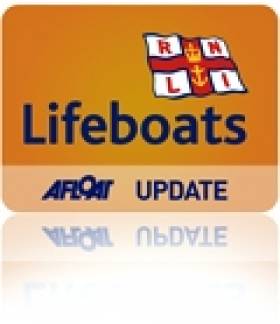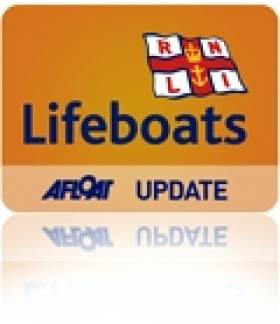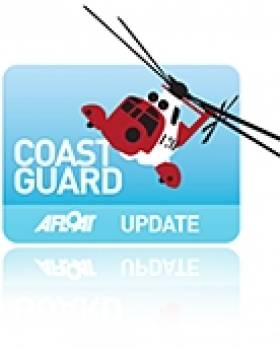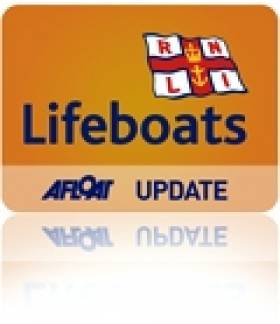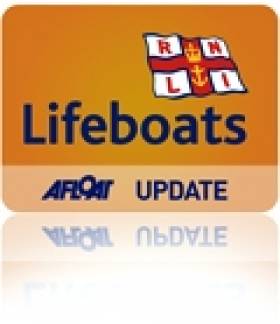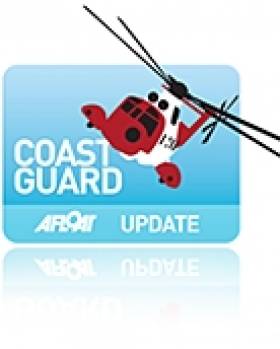Displaying items by tag: Lifeboat
RNLI Lifeboats Launch Over a Thousand Times in Ireland During 2010
Last year RNLI lifeboats rescued 1,094 people in Ireland, launching 1,002 times. Figures released today (Tuesday 25 January 2010) by the Royal National Lifeboat Institution (RNLI) show an increase of 8 per cent in the number of people brought to safety by Irish lifeboat crews compared to 2009 figures.
The busiest RNLI lifeboat station in Ireland last year was Enniskillen, where the crews on Lough Erne launched 64 times and rescued 82 people last year. The next busiest station was Crosshaven in Cork where volunteer lifeboat crew launched 54 times and brought 67 people to safety. RNLI Dun Laoghaire's lifeboats launched 50 times and the Aran Islands all-weather lifeboat launched 49 times bringing between them 107 people to safety. Kilmore Quay lifeboat station in Wexford, which last year received a new Tamar class lifeboat worth €3 million, rescued 85 people during 43 callouts.
In a breakdown of the causes of services for the RNLI last year 130 callouts were to persons in the sea, 329 launches were to power pleasure craft and 109 were to fishing vessels.
RNLI Divisional Inspector for Ireland Martyn Smith said: 'It's been another busy year for Ireland's 55 RNLI lifeboats with lifeboat launches topping one thousand for the first time last year. Every one of the rescues carried out by the RNLI in 2010 was only made possible due to the incredible generosity of the public, even in these difficult times.
'We are absolutely determined to make the best possible use of the funds that the public entrust to us – and we regularly re-examine everything we do. This ensures that we give the best possible support to our volunteers who may face the worst the sea can throw at them. These new figures show just how much time our crews sacrifice to help those in trouble at sea – but in addition, they spend even more time training, which is a further measure of their dedication and commitment.'
The RNLI, a charity that is independent of Government and reliant on donations, is urging the public to respond to its own call for help by supporting RNLI SOS Day this year on Friday, 28 January. To find out more log on to www.rnli.ie or call 1800 789 589
Related Safety posts
RNLI Lifeboats in Ireland
Safety News
Rescue News from RNLI Lifeboats in Ireland
Coast Guard News from Ireland
Water Safety News from Ireland
Marine Casualty Investigation Board News
Marine Warnings
Sunken Cruiser to be Lifted in Fenit
A Sealine motor cruiser that hit rocks in Tralee Bay early on Sunday morning on a run back from Ballydavid is due to be lifted on to Fenit pier this week. Eight people were rescued by Fenit lifeboat and the boat was towed into Fenit harbour where it is now lying on the bottom. Photos: Paul Dolan.


Related Safety posts
RNLI Lifeboats in Ireland
Safety News
Rescue News from RNLI Lifeboats in Ireland
Coast Guard News from Ireland
Water Safety News from Ireland
Marine Casualty Investigation Board News
Marine Warnings
Two Canoeists Call for Help from Belfast Coastguard
The emergency call stated that the two men, both in their early 50s, were off Copeland Sound between the coast and Donaghadee. Both men were wearing lifejackets. The man in difficulty was exhausted and needed assistance. The seas on scene were described as having a heavy swell.
Both the Bangor and Donaghadee RNLI inshore lifeboats were asked to launch and a fisheries patrol vessel, the 'Queen of Ulster' also offered assistance after hearing the radio exchanges.
During the incident, Belfast Coastguard kept in contact with the canoeist who had remained in his craft to ensure that both men were aware of the situation and that help was proceeding.
Louis McGookin, Duty Watch Manager at Belfast Coastguard said
"It was clear that the man in the water was absolutely exhausted and simply was unable to get back into his craft. Sea temperatures are at around 8 degrees Celsius at present and hypothermia is an ever present danger in prolonged immersion. Fortunately they were able to contact the Coastguard and using our knowledge of the tides in the area we were able to pinpoint his location. Both men were given a medical check when they arrived back at the shoreline and neither required any treatment."
Related Safety posts
RNLI Lifeboats in Ireland
Safety News
Rescue News from RNLI Lifeboats in Ireland
Coast Guard News from Ireland
Water Safety News from Ireland
Marine Casualty Investigation Board News
Marine Warnings
Fisherman Still Missing off Cork Harbour
UPDATE: Ballycotton RNLI lifeboat has launched this morning to help search for a missing person off Ringabella Bay in Cork Harbour. The alarm was raised when one fisherman managed to swim ashore shortly before 11am and alert the emergency services that another man was still in the water. A major air and sea search is currently taking place in the area for the missing fisherman. Ballycotton RNLI lifeboat, Crosshaven RNLI lifeboat, Coastguard helicopter Rescue 117 and the naval service have gathered in the area and a coordinated search is taking place.
Related Safety posts
RNLI Lifeboats in Ireland
Safety News
Rescue News from RNLI Lifeboats in Ireland
Coast Guard News from Ireland
Water Safety News from Ireland
Marine Casualty Investigation Board News
Marine Warnings
Ballycotton in Search for Missing Person
Ballycotton RNLI lifeboat, Austin Lidbury, has launched to assist in a search for a missing person off Ringabella Bay, near Cork harbour. The alarm was raised when a companion swam ashore and alerted the emergency services. Ballycotton RNLI lifeboat's eta is 11:40.
Related Safety posts
RNLI Lifeboats in Ireland
Safety News
Rescue News from RNLI Lifeboats in Ireland
Coast Guard News from Ireland
Water Safety News from Ireland
Marine Casualty Investigation Board News
Marine Warnings
RNLI Bangor Lifeboat launched to Assist Crab Fishing Boat
RNLI Bangor Lifeboat launched at 1:20 pm on Monday 17th January to assist 1 person aboard a 21ft crab fishing boat which had experienced gearbox mechanical failure close to shore.
Within minutes of the rescue pagers being activated, volunteer crew had launched RNLI Bangor Lifeboat and quickly located the crab fishing boat close to shore near Ballymacormick Point which is 1 ½ nautical miles north east of Bangor Harbour.
Calm weather conditions had allowed the skipper of the fishing vessel to make emergency repairs to the gearbox.
RNLI Bangor Lifeboat escorted the fishing vessel to the safety of Bangor Harbour and assisted the skipper with docking manoeuvres.
This is the first rescue call for RNLI Bangor Lifeboat in 2011.
Related Safety posts
RNLI Lifeboats in Ireland
Safety News
Rescue News from RNLI Lifeboats in Ireland
Coast Guard News from Ireland
Water Safety News from Ireland
Marine Casualty Investigation Board News
Marine Warnings
Fishermen Rescued From Sinking Vessel off Ardglass
Belfast Coastguard received a Mayday call at 5:54pm from the Newry registered vessel, which operates out of Ardglass, and immediately sent the Southdown and Portaferry Coastguard Rescue Teams to the scene. The launch was requested of the RNLI Portaferry inshore lifeboat. The Irish Coastguard Rescue Helicopter was tasked but was later stood down.
Steve Carson, Watch Manager, Belfast Maritime Rescue Coordination Centre, said:
"The crew aboard the fishing vessel were rescued by the inshore lifeboat and then taken to Ardglass Harbour where they received medical attention; one of the crew has since been taken to Downpatrick Hospital.
It is imperative to always ensure you are carrying the correct safety equipment and have it serviced regularly. Due to the prompt and appropriate action of the crew I am pleased to say they are all safe but shaken by their traumatic experience.
The rescue was successfully coordinated by Belfast Coastguard with assistance from their colleagues at Dublin, Liverpool and Holyhead Coastguard Stations.
The vessel has now been successfully refloated and is now alongside in Ardglass Harbour."
Concern for Small Fishing Boat
Two men in a small dinghy had earlier put to sea in poor weather conditions on Wednesday 29 December. Visibility was restricted due to sea fog. When the dinghy did not return the Coast Guard were alerted. At 17:20, both the Baltimore lifeboat and the Castletownbere lifeboat were requested to provide support.
Coxswain Kieran Cotter was proceeding to Dunmanus Bay on the Tyne class all-weather lifeboat Hilda Jarrett, when the Coast Guard indicated that the two men had been observed coming ashore safe and well. The search and rescue operation was stood down.
This incident echoes a similar one earlier this year. On the 5th January 2010 almost certain tragedy was averted when the inshore lifeboat rescued two men in a 7ft dinghy, which was drifting out to open sea when their outboard failed.
Lifeboat crew on this service ; Kieran Cotter, Micheal Cottrell, Ronnie Carty, Brian McSweeney, Diarmuid Collins.
Related Safety posts
RNLI Lifeboats in Ireland
Safety News
Rescue News from RNLI Lifeboats in Ireland
Coast Guard News from Ireland
Water Safety News from Ireland
Marine Casualty Investigation Board News
Marine Warnings
Crosshaven Lifeboat Called out Twice on Last Day of 2010
The Volunteer crew members were awoken by pagers just after 4am, and requested to launch to the aid of a woman on rocks near Myrtleville. A combined rescue operation by the RNLI, Fire Service, Crosshaven Coastguard and the HSE brought the women to safety and onwards to hospital, where she is recovering.
The volunteer crews headed back to their beds at 6.30 in the morning.
The afternoon peace was shattered by the shrill sound of pagers, again calling the crew. Valentia Marine rescue Centre informed the station of a 38 foot commercial fishing vessel which had become entangled in its own nets. The volunteer crew of Con Crowley, Gary Heslin and Vincent Fleming made their way through a moderate to rough sea to the vessel which was near Power Head. As the vessels nets were also attached to the seabed, the nets had to be cut away before the Lifeboat could establish a tow back to Crosshaven, arriving some two hours later.
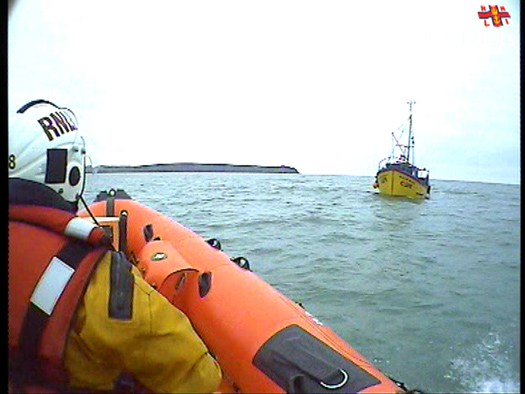
A video grab of the afternoon service yesterday to the disabled Fishing Vessel. Photo: Crosshaven Lifeboat Station
Related Safety posts
RNLI Lifeboats in Ireland
Safety News
Rescue News from RNLI Lifeboats in Ireland
Coast Guard News from Ireland
Water Safety News from Ireland
Marine Casualty Investigation Board News
Marine Warnings
Dun Laoghaire Lifeboat Remembers Christmas Eve Tragedy of 1895
The RNLI lifeboat station in Dun Laoghaire is holding it's traditional ceremony at midday at a memorial stone close to the station.
The 15 volunteers lost their lives when their lifeboat capsized while attempting to rescue those on board the SS Palme that ran aground off Blackrock in Co. Dublin.
Those who also lost their lives this year while serving with the RNLI will also be remembered.
Related Safety posts
RNLI Lifeboats in Ireland
Safety News
Rescue News from RNLI Lifeboats in Ireland
Coast Guard News from Ireland
Water Safety News from Ireland
Marine Casualty Investigation Board News
Marine Warnings


























